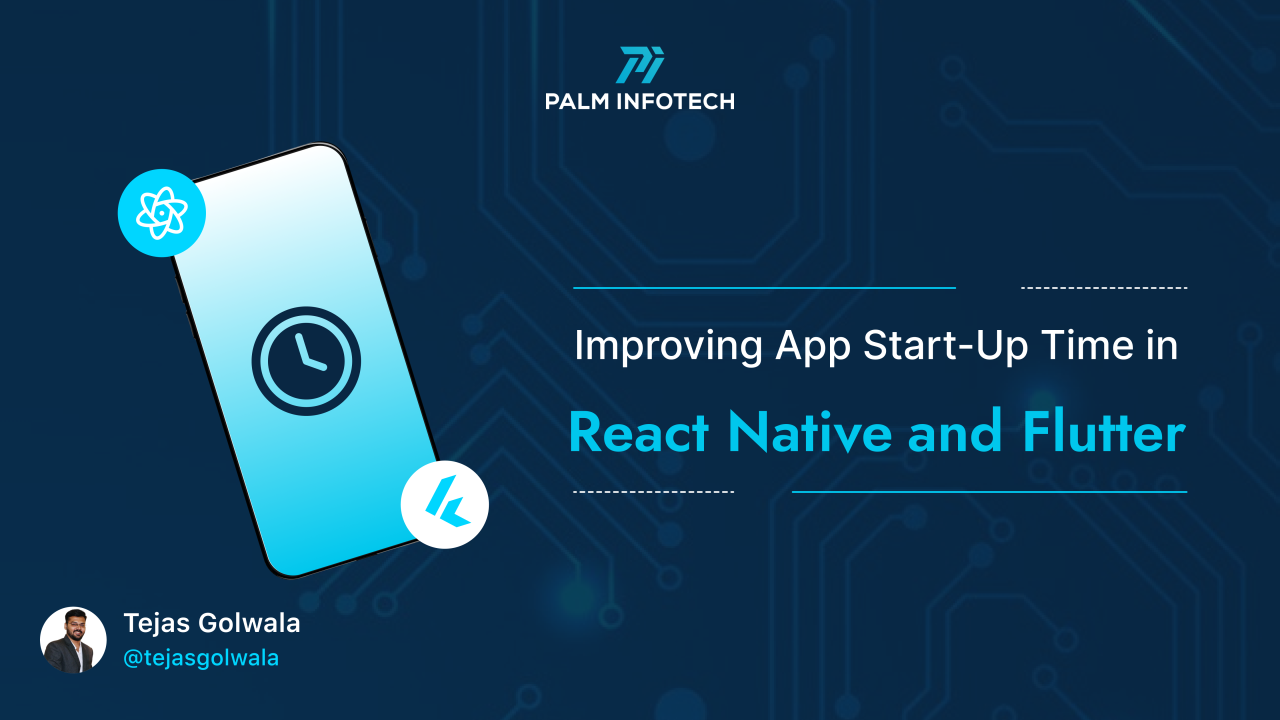
Improving App Start-Up Time in React Native and Flutter
Tejas Golwala
?? CEO @ Palm Infotech | ?? Mobile App Solutions | ?? Expert in Swift, Kotlin, React Native, Flutter | ?? Agile Enthusiast | ?? 13+ Years Industry Experience | ?? Innovator in Tech Solutions
App start-up time is a critical factor in delivering a great user experience. When an app takes too long to load, users may lose interest and abandon it altogether. For frameworks like React Native and Flutter, which focus on cross-platform development, optimizing start-up time is essential to ensure smooth performance across both iOS and Android.
By implementing smart strategies like code optimization, resource management, and leveraging native capabilities, developers can significantly reduce app loading times and provide users with a seamless experience right from the start.
A) App Start-Up Time
App start-up time refers to the duration it takes for an application to load and become ready for user interaction after it is launched. It is a critical metric in mobile app performance as it directly impacts the user experience. A faster start-up time enhances user satisfaction, while a slow start-up can lead to frustration, app abandonment, or poor reviews. For competitive markets like mobile apps, improving start-up time can significantly boost retention rates and user engagement.
Factors Affecting Start-Up Time
Several factors influence the start-up time of mobile applications:
In React Native, the JavaScript bridge and initialization of native modules can add delays.
In Flutter, compiling and rendering widgets may contribute to start-up time.
Optimizing asset size and format can help reduce delays.
By understanding these factors, developers can identify bottlenecks and implement targeted optimizations to improve app start-up performance.
B) Initial Load Optimization
a) Techniques to Reduce App Initialization Time
Load only the essential components and features during start-up, deferring non-critical resources until they are needed.
Reduces the initial load time by prioritizing what’s visible and required immediately.
Break down resources such as images, fonts, or libraries into smaller chunks.
Load these chunks dynamically based on user interaction or navigation to specific app sections.
Minify JavaScript or Dart code to reduce file sizes.
Use compression techniques (e.g., Gzip or Brotli) to shrink the app bundle further.
Cache frequently used resources locally to avoid reloading them from the server.
Preload critical assets like splash screen images during the app build phase.
Comparison of React Native and Flutter Approaches
a) React Native:
b) Flutter:
By leveraging these techniques and framework-specific optimizations, developers can significantly reduce app initialization time, enhancing the user experience across both platforms.
b) Tips to Delay or Load Native Modules Only When Needed
In React Native, use dynamic imports for modules to ensure they are only loaded when needed. Example:
const SomeNativeModule = require('SomeNativeModule');
In Flutter, use conditional imports or deferred loading to initialize plugins or resources on demand.
Break native module logic into smaller, manageable units that can be loaded individually rather than all at once.
Load native modules asynchronously to avoid blocking the main thread during app start-up.
Use tools like React Native Performance Monitor or Flutter’s DevTools to identify and measure which native modules are contributing to delays. Optimize or defer these as necessary.
By minimizing and managing native module initialization effectively, both frameworks can achieve faster app start-up times, providing users with a smoother and more responsive experience.
C) Optimizing JavaScript and Dart Code
a) Reducing JavaScript Bundle Size in React Native
b)Optimizing Dart Code in Flutter
D) Asset Management
a) Managing Images, Fonts, and Other Resources
b) Tools and Techniques
React Native: Use libraries like react-native-fast-image for efficient image handling and caching.
Flutter: Define assets in the pubspec.yaml file and use the precacheImage method to preload images during initialization.
E) Reducing Overhead from Third-Party Libraries
a) Identifying and Removing Unnecessary Libraries
b) Evaluating Library Performance
Best Practices
Keep third-party dependencies to a minimum.
Regularly update libraries to their latest versions for improved performance and bug fixes.
By following these simple and effective strategies, developers can improve app start-up times in both React Native and Flutter while maintaining a smooth user experience.
F) Using Performance Monitoring Tools
a) Tools
G) Leveraging Platform-Specific Optimizations
a) Android Optimizations
b) iOS Optimizations
H) Future Trends in Start-Up Optimization
a) Emerging Technologies
b) Cross-Platform Practices
Enhanced caching mechanisms and better handling of resource preloading are gaining traction.
Cloud-based tools for real-time performance monitoring are on the rise.
I) Case Studies and Real-World Examples
a) Apps
React Native: A food delivery app reduced start-up time by optimizing its JavaScript bundle and removing redundant dependencies.
Flutter: A finance app improved load times by implementing asset preloading and AOT compilation.
Improving app start-up time is crucial for user satisfaction and retention. By using performance monitoring tools, applying platform-specific optimizations, and learning from successful implementations, developers can ensure smooth and fast app launches. As frameworks like React Native and Flutter evolve, start-up optimization will become even more efficient.
If you have any questions or need more information about these topics, feel free to reach out through our website: https://palminfotech.com/ . We’re here to help!
#AppDevelopment #ReactNative #Flutter #PerformanceOptimization #StartupTime #MobileApps #CrossPlatform #TechTrends